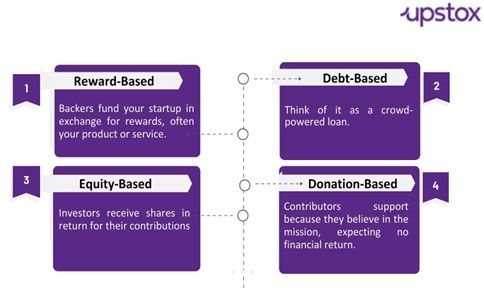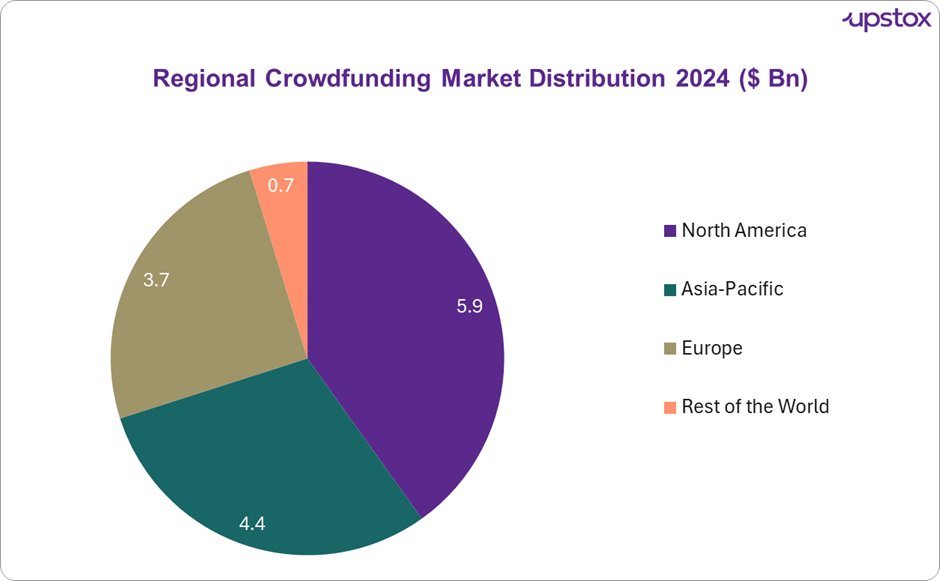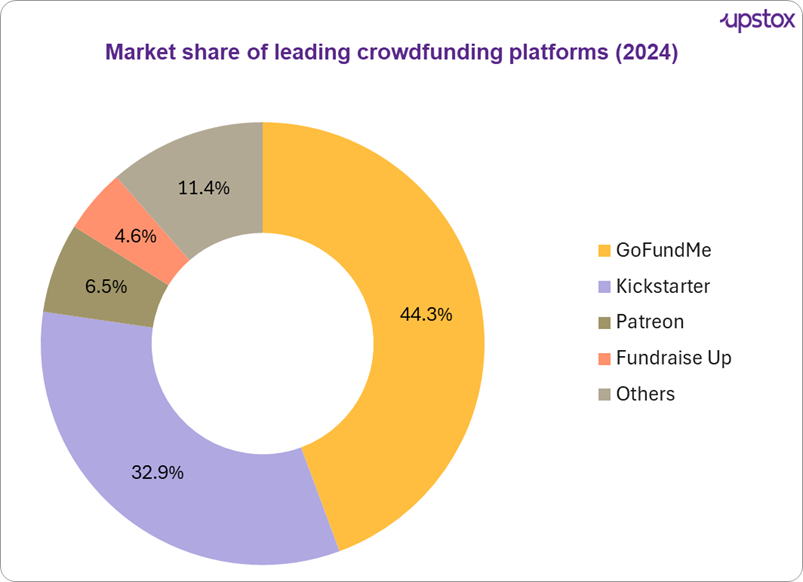Upstox Originals
Power of the crowd: How collective support fuels big dreams
.png)
5 min read | Updated on February 17, 2025, 18:40 IST
SUMMARY
Imagine turning your dream into reality with global support—no banks, no loans, just people who believe in your vision. Crowdfunding has transformed fundraising, turning bold ideas into reality through collective backing. As the market grows, digital platforms empower entrepreneurs and changemakers. Whether it's a startup, a passion project, or a cause you care about, this modern funding approach shows that a little help from many can go a long way!

North America dominates the crowdfunding industry
Crowdfunding is not a new concept. But its transformation in the digital age has redefined how startups and small businesses bring their ideas to life. By harnessing digital platforms and social media, entrepreneurs can connect with a global network of backers—ranging from individuals to investment firms—who believe in their vision.
How crowdfunding works
It’s a process where individuals or businesses raise money for their projects by reaching out to a crowd through online platforms like Kickstarter or GoFundMe.
Creators share their ideas, set funding goals, and offer rewards to backers who contribute. Supporters chip in, spreading the word and helping turn dreams into reality. If the goal is met, the funds are used to bring the project to life, making crowdfunding a powerful way to transform ideas into achievements with collective effort.
Types of crowdfunding

Regional breakdown of crowdfunding market share
Crowdfunding has been shaping the global financial landscape for over a decade. While North America pioneered its early growth, regions like Asia-Pacific and Europe have steadily gained traction, fueled by increasing digital adoption, thriving entrepreneurial ecosystems, and evolving regulatory frameworks.
-
North America: Dominates the crowdfunding market due to widespread online platform usage, a strong entrepreneurial culture, and supportive equity crowdfunding regulations.
-
Asia-Pacific: Follows closely, fueled by growing internet access, the rise of small and medium-sized enterprises (SMEs), and increasing awareness of alternative financing in countries like China, India, and Southeast Asia.
-
Europe: Backed by a thriving startup ecosystem and favorable regulatory frameworks in key markets.
-
Rest of the World: Shows rising interest, particularly in Latin America, the Middle East, and Africa, supported by global crowdfunding platforms and increasing digital penetration.

Source: Business Research Insights
Power players of crowdfunding
Crowdfunding has its all-stars, each making waves in unique ways. Leading the charge is GoFundMe, a favourite for personal and charitable causes. Close behind is Kickstarter, which champions creative and innovative projects. Patreon ranks third, empowering creators with fan-based support, while Fundraise Up focuses on helping fundraisers streamline their campaigns. Together, these platforms set the stage for dreams to take flight.

Source- 6sense
List of highest-funded crowdfunding projects
Crowdfunding campaigns like Exploding Kittens and Coolest Cooler show how innovative ideas can achieve massive success. Exploding Kittens used humor and simplicity to become one of the most-backed projects ever, later expanding into a Netflix animated series. Coolest Cooler reworked its product and launched at the right time, turning initial failure into a market sensation.
| Project | Funds raised | About | Platform |
|---|---|---|---|
| Pebble Time | $ 20.3 Mn | A smartwatch company | Kickstarter |
| Exploding Kittens | $ 8.7 Mn | A quirky card game | Kickstarter |
| Coolest Cooler | $ 13.2 Mn | A high-tech cooler that combines functionality with fun | Kickstarter |
| Critical Role | $ 11.3 Mn | Live-streamed tabletop roleplaying game featuring a group of prominent voice actors | Kickstarter |
| Frosthaven | $ 12.9 Mn | A board game | Kickstarter |
| Peak Design Travel | $ 12.1 Mn | Premium travel gear | Kickstarter |
Source-thecrowdfundingformula
These projects showcase that success in crowdfunding isn’t just about the idea—it’s about timing, marketing, and the ability to build a strong community around a vision.
Flip side of crowdfunding
Crowdfunding presents several challenges. Managing investor expectations can be tricky, as hype often leads to pressure to deliver. Building trust is difficult, especially with skeptical investors who prefer traditional options. Deciding how much to ask for is also challenging—high valuations may deter backers, while low ones can undervalue your startup.
Additionally, choosing the right platform and protecting your ideas add layers of complexity, making crowdfunding a test of strategy and resilience. It’s also important to learn from failed projects, such as Pebble Time, which disappointed backers by selling to FitBit and ceasing support, or Zano, which couldn’t deliver a functional product, highlighting the risks of poor execution and unmet promises in crowdfunding.
Future of crowdfunding in India
The future of crowdfunding in India is evolving within the legal framework set by regulatory bodies. While SEBI has deemed equity-based crowdfunding illegal, donation-based and reward-based crowdfunding remain viable and legally accepted methods for raising funds.
As digital platforms expand, individuals, NGOs, and startups can continue to leverage reward and donation crowdfunding to support social causes, medical emergencies, and creative projects. With growing public awareness and technological advancements, crowdfunding is expected to remain a key tool for community-driven fundraising in India.
In summary
Crowdfunding has emerged as a vital mechanism for empowering innovators and creators, transforming how ideas come to life. As the industry matures, it showcases the powerful connection between collective effort and entrepreneurial success.
While challenges like trust and investor expectations remain, the integration of technology promises to enhance transparency and engagement. As we look ahead, crowdfunding is not just reshaping funding landscapes; it is redefining how communities invest in the visions of tomorrow.
About The Author
Next Story
